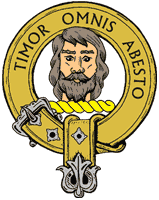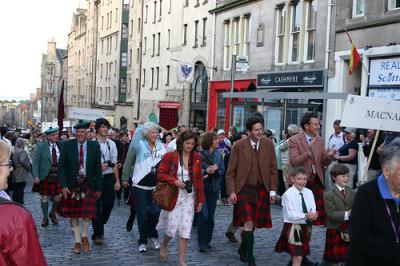Macnab of Macnab - Scotland's Newest Chief

Clan Macnab – Let Fear Be Far From All
One of the most fascinating things about Scotland is the way that a country steeped in history and tradition is colliding with the new. This is especially true of Scotland’s clans – distinguished by heraldry tracing back over a thousand years – and how this is manifesting itself in modern life. Last week I had the pleasure of meeting my first chief – Macnab of Macnab, 24th chief of Clan Macnab, and perhaps Scotland’s newest chief. Expecting to meet a dirk-wielding highlander straight from a history book, I instead found myself in an office in Edinburgh’s New Town, chatting to the Director of Country House Sales at Savills Estate Agents.
“It’s quite interesting how people react to my title. People who know about the clans, in particular people from the Highlands, have been saying ‘Congratulations, I’m sure you’ll do a good job’. Which is very bolstering. But to other people, especially in the South, they don’t have a clue what it means. To them it’s just a strange name.”
Jamie Macnab was announced chief of Clan Macnab in January this year upon the passing of his father, James Charles Macnab. Born in 1963 in Edinburgh, a pipe band greeted the infant Jamie and his parents upon return from the maternity hospital to the village of Killin, deep in Macnab territory. A newspaper article at the time referred to him as the ‘Younger, Younger of Macnab’ as his father, then heir, was known as ‘Younger Macnab’. However it was never something that differentiated him from other children in the village. “I was just Jamie, I don’t think anyone ever thought about that. I wasn’t particularly a leader, I had my pals and got on with them in the normal way. But I’ve known all my life that one day I would be clan chief, so I’ve had a lot of time to get used to the idea.”
“We all lead pretty ordinary lives. There’s a range of people who are clan chiefs, from the Duke of Buccleuch, to one of the chiefs who sells goods by hand up and down The Royal Mile, and another is French. So there’s no typical chief.”
Like other Scottish clans, the Macnabs are scattered globally. “There’s not a Macnab in the Killin telephone directory at the moment, we’ve all been very dispersed. But the people who live in Killin do recognise that this is where the Macnabs are from.” The Macnabs were present at The Gathering, the 2009 clan convention and largest recorded meeting of Scottish chiefs. “The Gathering was described as life-changing by a lot of clansmen from Scotland and abroad, and it was for me because there aren’t that many Macnabs in Scotland. My father and I manned the Macnab tent from 9 o’clock in the morning till 10 o’clock at night, and I met the most fantastic collection of people, it was truly inspirational… The fact that they were all so pleased to come to Scotland and pleased to connect with us, it was all very humbling.”
“One clansman said something to me that had a real resonance, and suddenly made it all make sense. Macnabs are not necessarily coming to a clan event to meet me – although that is part of it because I’m the representative of the clan. But it’s more to work out where they fit in. Finding out where you come from leads to quite a strong path of emotion in people, and it would be fantastic if we could help people with their genealogy to knit the family heritage together. All the chiefs lineage is pretty well documented. For me, on my fathers side, I don’t even have to think about who my great, great grandfather is because it’s all in a booklet. But most people don’t have that, so it would be nice to give them a framework to work within.”
He draws attention to how important the clans are to modern-day Scotland. “There are five million people living in Scotland, but worldwide there are thirty million that claim Scottish descent. So for a small country like Scotland with a limited economy, heritage is hugely important to tourism. The chiefs and clans play a part in that to make Scotland relevant in the modern world, because linking with your past is a very powerful thing.” Using the web and social media to connect Macnabs is a high priority on Jamie’s list for the future of Clan Macnab. His father had no concept of the internet, so Jamie wants the Macnab presence to be as visible and approachable online as it has been in person. “Over the last five years there has been a lot of correspondence between Macnabs around the world, and I want to build on this communication. It’s my challenge to try and work out how to pull them all together”.
Jamie is hoping to reestablish the Macnab Clan Society in Scotland, and hopes to meet with the American Clan Macnab Societies. “A lot of Americans are more Scottish than the Scots. It’s probably because they’re geographically removed. If you’re in Scotland you’ve probably got quite a secure thought of your place and where you’ve come from. But when you’re removed from it, it then becomes more important… So I’ll have to get out to the States.”
I asked Jamie if any clan rivalries from the old days still survived, and he proudly showed me his signet ring depicting the severed head of a Neish. Legend goes that the Macnabs and Neishes had a great battle near Loch Earn. The defeated Neishes took refuge on an island in the Loch, managing to ransack all of the Macnab Christmas provisions as they were being transported along the Loch to Killin. Clansman Smooth John Macnab was a huge, terrifying highlander, and one of four brothers. Their father said “If my lads were lads, I’d have my Christmas dinner.” The brothers picked up a boat and carried it over a mountain and back down and onto Loch Earn and rode it over onto the island where Smooth John hammered on the door of the dwelling on the island. Drunk on Macnab wine, the Neishes shouted out “Who’s there?” to which Smooth John replied “Who would you least like it to be?” They replied “Smooth John Mcnab”, to which he said “Smooth John it is”. With one smash of the hilt of his sword he broke through and beheaded everyone inside. There was no food or wine left, but the brothers took a sack of heads back over the hill. When they arrived back in Killin their father asked them if they had any Christmas dinner, to which Smooth John replied “No, but I’ve got some balls for the children to play with” and emptied out all of the heads onto the floor.
A hero of the Macnabs, Smooth John’s antics are centuries removed from modern clan life. “I haven’t had much of that in my lifetime. I’ve played a bit of rugby but that’s about it… When I was at college there was a guy called Ed Neish who knew the story of our two families. He’d had an accident and he had metal plating in his neck, so I was always joking with him that if I’d ever had a need to behead him I would have needed an angle grinder”.
I also wondered how clan life coincides with Jamie’s family life. He explained that they’re a very ordinary, Edinburgh-based professional family. He told me his wife said that it was very worthwhile being married to a clan chief the day that Chanel came knocking looking for chiefs to attend their recent show at Linlithgow Palace. And how does James, Jamie’s son feel about his eventual chieftanship? “His only experience was The Gathering in 2009 when he was 9 years old. He had a sudden realisation – ‘I have to stand up the front so there must be something in this’. I asked him about it again this morning and he just said ‘boring question’. So there’s no real concept at the moment I don’t think. I think it’s something that will gradually soak in on him over a period of time. It’s quite a mysterious thing for him.”
As I left Jamie’s office and walked along Princes Street in the shadow of Edinburgh Castle, I thought about how many clan chiefs had walked in the same shadow over the years. My first meeting with a chief gave me a tangible sense of Scotland’s past, and as clans adjust to life in modern times, it seems the way forward is helping people connect to their past in a very 21st century way.

Clan Macnab at the Clan Parade. The Gathering, Edinburgh 2009.
- March 7, 2013 5:14 pm
- ·
 Margaret Moffet, Pauline Campbell, Amanda Moffet and 1 other person likes this.
Margaret Moffet, Pauline Campbell, Amanda Moffet and 1 other person likes this.- March 20, 2013
- ·
- Like
- ·
- 1 person

